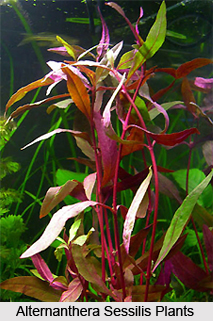 Alternanthera sessilis is a prostrate or procumbent, annual or perennial herb. The branches are raised from the root and are up to 50 cm long. They are often purplish in colour and glabrous. The leaves are fleshy, generally 1.3-3 centimetres long and 0.5-1 centimetres wide though the leaves are larger in wet habitats, linear-elliptic, oblong or obovate, apex rounded and base cuneate. The flowers are inconspicuous, white, borne in small, axillary heads; bracts are ovate or obovate and are 1 mm long. The bracteoles are shorter, persistent; subequal, ovate and acute. Utricleare cordi-form and are strongly compressed. The seeds are orbicular. The plant bears flowers and fruits throughout the year.
Alternanthera sessilis is a prostrate or procumbent, annual or perennial herb. The branches are raised from the root and are up to 50 cm long. They are often purplish in colour and glabrous. The leaves are fleshy, generally 1.3-3 centimetres long and 0.5-1 centimetres wide though the leaves are larger in wet habitats, linear-elliptic, oblong or obovate, apex rounded and base cuneate. The flowers are inconspicuous, white, borne in small, axillary heads; bracts are ovate or obovate and are 1 mm long. The bracteoles are shorter, persistent; subequal, ovate and acute. Utricleare cordi-form and are strongly compressed. The seeds are orbicular. The plant bears flowers and fruits throughout the year.
Alternanthera sessilis is commonly known as `sanchi` in Bengali, Gio- jihra in Sanskrit and `ponnagannikkirai` in Tamil Nadu. Alternanthera sessilis is widely distributed throughout the Old World tropics. In India it is found as a weed across a range of open site conditions. It is found hugely in moister habitats, throughout the warmer parts of the country to an altitude of 1200 metre in the Himalayas. Often the plant is widely cultivated for its edible young shoots and leaves.
The whole plant of Alternanthera sessilis is one of three sources of the Ayurvedic drug Lonika, which is used to treat wounds, flatulence, cough, bronchitis and diabetes. This plant is also reckoned as an important ingredient of several compounds of Ayurvedic preparations. The people of Bihar reportedly use the plant to treat night blindness. A poultice of the herb is reportedly useful to promote the healing of boils. The leaves and stems of this herb are used as galactagogue and febrifuge. The fresh and immature shoots and leaves are considered useful for relieving indigestion and are eaten as a cooked vegetable or in soups. To cure inflamed wounds the roots are applied externally. Among the Santhalis and Paharia in eastern Bihar, an extract of the roots, crushed with the bark of Alstonia scholaris (Apocynaceae), is taken with cow`s milk for the treatment of spermatorrhoea.



















